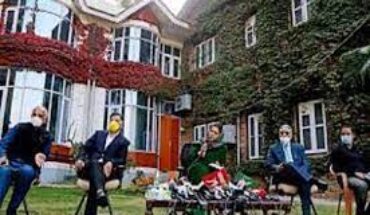New Delhi; Air Quality Index (AQI) of Delhi has become an increasing cause of concern. Further, the ITO crossing of New Delhi has recorded particularly high air pollution levels. In response to these developments and keeping in view its community responsibilities, the office of the Comptroller and Auditor General of India which is located at Bahadur Shah Zafar Marg has taken steps to establish an Urban Forest in the Office Park.
Keeping in view the limited area, local material was adopted to enable intensive afforestation. The forest is made up of trees which are native to the area and are three dimensional, multi-layered communities having 30 times the surface area of the greenery of single-layered lawns, and have more than 30 times the ability to protect against natural disasters and to conserve the environment.
Inaugurating the Urban forest, Union Environment Minister, Prakash Javadekar expressed happiness and said that this would be a dense urban forest with multiple tree layers including 12000 saplings of 59 indigenous species in another year or so.
Highlighting the importance of Urban forests,Javadekar said that they are the lungs of the cities and act as an oxygen bank and Carbon Sink. The Environment Minister appreciated that the Miyawaki method of forest creation is employed which could help in reducing the temperature by as much as 14 degree & increase the moisture by more than 40%.
With minimal maintenance, including watering and de-weeding, the urban forest will be self-sustainable by October 2021. The Urban forest has an ecosystem which has the capacity to restore habitat for birds, bees, butterflies and microfauna. These are essential for pollination of crops and fruits and to help maintain a balanced ecosystem.
A dense forest ecosystem has been created in an area that is little over 1 acre in size. The multi-layered forest has shrubs, small to medium-size trees and tall trees carefully arranged as peripheral and core plant communities.
Some of the rare native species planted here include Anogeissus pendula (Dhonk), Diospyros cordifolia (Bistendu), Ehretia laevis (chamrod), Wrightia tinctoria (Doodhi), Mitragyna parvifolia (Kaim), Butea monosperma (Palash), Prosopis cineraria (Khejri), Clerodendrum phlomidis(Arni), Grewia asiatica (Falsa), Phoenix sylvestris (Khajoor) and Helicteres isora (Marodphali). The species selected are part of Delhi’s potential natural vegetation and are best suited to the region’s terrain, climate and soil.
The urban forest sends out an action-oriented message of bringing back lost environmental protection forests. In-depth field surveys of potential natural vegetation, well planned native species’ propagation and restoration projects like these are the need of the hour. The office of the CAG of India believes that initiatives like these will help us move towards a state of better ecological balance, especially in cities. It is a small yet significant contribution to Delhi’s ecosystem, one that could inspire people to reclaim and restore their natural surroundings.
It is noteworthy that recently on the occasion of World Environment Day, the government announced implementation of the Nagar van scheme to develop 200 Urban Forests across the country in next five years with a renewed focus on people’s participation and collaboration between Forest Department, Municipal bodies, NGOs, Corporates and local citizens.






